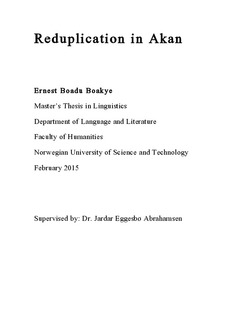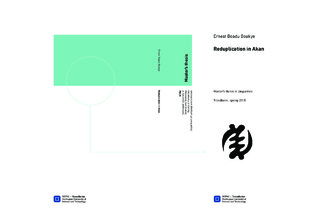| dc.description.abstract | This thesis is a study of reduplication in Akan, a Kwa language spoken in Ghana, West Africa and some parts of Cote D’Ivoire. Grounded within the two frameworks; autosegmental phonology and optimality theory, this thesis analyzes the phenomenon both from a formal viewpoint where I analyze the morphophonological properties of reduplicated forms in the Akan language and also from a functional point of view where I discuss the functions (syntactic, semantic and pragmatic) that these reduplicated forms perform in the language.
Chapter one presents a brief introduction to the Akan language and its speakers, and a general introduction of the topic, reduplication, as it pertains across languages.
Chapter two deals with a review of the frameworks adopted for this study and also of some aspects Akan phonology, which are considered to be necessary for a better understanding of reduplication in Akan. Aspects such as Akan sound inventory, vowel harmony, tone and the structure of the Akan syllable are reviewed in this chapter.
Chapter three presents the formal analysis of reduplication in Akan focusing on words from the classes: nouns, adjectives, numerals and verbs. The discussion focuses on the morphophonological properties of the reduplicated forms. An earlier analysis of reduplicated forms in Akan by McCarthy and Prince (1995) that focused only on verbs with CV syllable structure is found to be untenable so an alternate analysis that encompasses other word classes is proffered based on attested data.
The issue of what happens to tone when a form is reduplicated in a tone language like Akan is discussed in Chapter four. The chapter examines whether the interaction between reduplication and prosody allow for the transfer of prosodic features such as tone along with the reduplicant.
Chapter five focuses on the analysis of the functions that reduplicated forms in Akan perform. The functions, which includes reduplicating as a means of lexical adjustment, to indicate the attributive and predicative use of a word, to indicate plurality of subject and object respectively, derivationally to change the class of a word, as a means of attenuation, augmentation (to indicate intensity, frequency, repetition), emphasis and to imitate sounds are discussed in this chapter. | nb_NO |

